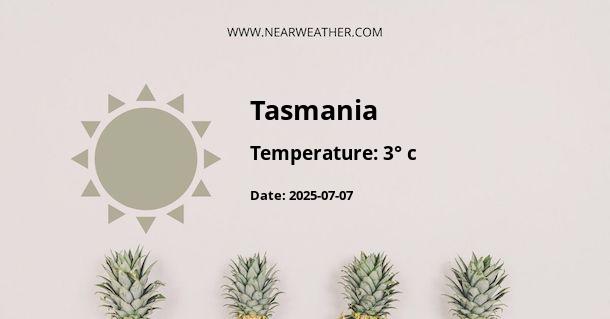Climate and Weather in Tasmania, Australia
Tasmania, the southernmost state of Australia, is known for its diverse and unique climate. Located in the temperate zone, Tasmania experiences cool summers and mild winters, with a climate influenced by its maritime surroundings and the presence of various mountain ranges. The state's weather patterns are shaped by its geographical location, resulting in a range of climates across different regions of Tasmania.
Temperature
The temperature in Tasmania varies throughout the year, with distinct seasonal changes. The summer months, from December to February, are generally mild and comfortable, with average temperatures ranging from 17°C to 23°C (63°F to 73°F). However, temperatures can occasionally rise above 30°C (86°F) during heatwaves.
Winter in Tasmania, from June to August, brings cooler temperatures with averages ranging from 3°C to 11°C (37°F to 52°F). In some parts of the state, particularly in higher elevations, snowfall is common during this period, providing opportunities for skiing and other winter activities.
Rainfall
Tasmania is known for its abundant rainfall, which contributes to its lush green landscapes and diverse ecosystems. The state receives rainfall throughout the year, with some regional variations. The west coast of Tasmania, including areas such as Strahan and Queenstown, receives the highest annual rainfall, averaging around 2,000 millimeters (79 inches). In contrast, the eastern parts of the state, including Hobart and Launceston, receive comparatively less rainfall, around 600 to 800 millimeters (24 to 31 inches) annually.
The rainfall distribution throughout the year is relatively even, with no distinct dry season. However, the winter months tend to be wetter, with heavier rainfall and more frequent showers. The summer months, while generally drier, can still experience rainfall due to frontal systems and occasional thunderstorms.
Wind
Being an island state, Tasmania is influenced by strong winds, particularly along its coastal regions. The Roaring Forties, a band of strong westerly winds that encircles the globe in the Southern Hemisphere, affects Tasmania's weather patterns. These winds can bring both cool air from the Southern Ocean during summer and cold air from Antarctica during winter.
The wind patterns in Tasmania can vary depending on the region. The western coast experiences more frequent and stronger winds due to its exposure to the Roaring Forties, while the eastern coast is relatively sheltered. Inland areas, particularly those surrounded by mountain ranges, often experience less wind compared to coastal regions.
Sunshine Hours
Tasmania enjoys a reasonable amount of sunshine throughout the year, although the number of sunshine hours can vary by season. In summer, the state experiences longer daylight hours, with an average of 8 to 9 hours of sunshine per day. In contrast, winter days are shorter, with an average of 4 to 5 hours of sunshine per day.
The northern and eastern parts of Tasmania generally receive more sunshine compared to the western and southern regions. Hobart, the capital city, enjoys an average of 2,200 sunshine hours per year, making it one of the sunniest cities in the state.
Climate Zones
Tasmania can be divided into several distinct climate zones based on temperature and rainfall patterns. The coastal regions, particularly along the western coast, have a mild oceanic climate with relatively cool summers and mild winters. These areas experience high rainfall and are characterized by their lush rainforests and rugged landscapes.
The central and northern parts of Tasmania have a more temperate climate, with warmer summers and cooler winters compared to the coastal areas. These regions experience less rainfall and have a mix of agricultural and forested landscapes.
The highland areas, including the Central Plateau and the peaks of the Western and Eastern mountain ranges, have a subpolar climate. These regions have colder temperatures throughout the year, with snowfall during winter and cool summers. They are home to alpine vegetation and provide ideal conditions for winter sports and wilderness adventures.
Extreme Weather Events
While Tasmania generally experiences mild weather, it can also be susceptible to extreme weather events. Bushfires are a significant risk during the summer months, particularly in areas with dry vegetation and strong winds. The state has experienced devastating bushfire events in the past, such as the 2019-2020 bushfire season, which had a significant impact on the island's ecosystems and communities.
Tasmania is also prone to occasional severe storms, including thunderstorms and gales, which can cause localized damage and disruption. Flooding can occur during periods of heavy rainfall, particularly in low-lying areas and near rivers.
Conclusion
Tasmania's climate is diverse and influenced by its unique geographical location. The state experiences mild summers, cool winters, and abundant rainfall throughout the year. The western coast receives the highest rainfall, while the eastern parts of the state are relatively drier. Tasmania's wind patterns are influenced by the Roaring Forties, and sunshine hours vary by season and region. The different climate zones across the state, from the coastal regions to the highlands, contribute to Tasmania's diverse ecosystems and landscapes. While extreme weather events can occur, Tasmania's climate overall provides a pleasant and varied experience for both residents and visitors.
A - Tasmania's Latitude is -42.000000 & Longitude is 147.000000.
A - Weather in Tasmania is 5° today.
A - Climate Conditions in Tasmania shows overcast clouds today.
A - Humidity in Tasmania is 85% today.
A - Wind speed in Tasmania is 21.53 km/h, flowing at 9° wind direction. today.
